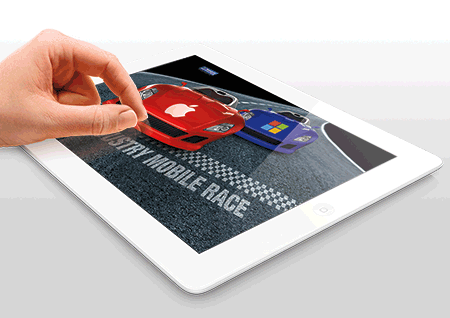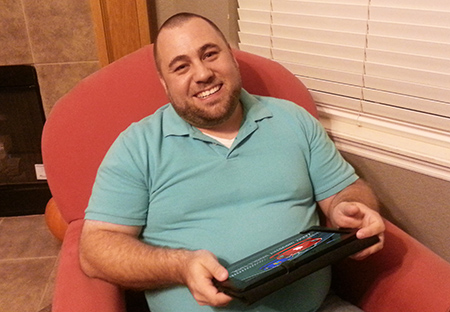Originally published in our free TL NewsWire newsletter. Instead of reading TL NewsWire here, sign up now to receive future issues via email.

Legend has it that Steve Jobs did not want to create a tablet unless it could attain a level of utility beyond surfing the web in the bathroom (though I suspect many iPads spend a lot of quality time there).
Hundreds of tablets currently exist, but only three can handle serious legal work. Coincidentally, all three of these tablets launched within the past week:
• iPad (Fourth Generation): $499 to $829
• iPad mini: $329 to $659
• Surface with Windows RT: $499 to $699
You've no doubt read about these tablets in mainstream publications. Therefore, instead of describing them in typical TL NewsWire fashion, I'll discuss them in the context of the legal industry.
Paper Replacement
Earlier this week, I published an opinion essay — Can the iPad mini Play a Role in the Lives of Lawyers? — in which I suggested using the iPad mini for note-taking.
Note-taking on a tablet is currently a niche activity. The iPad and Surface with Windows RT seem (to me) too large and heavy for note-taking. The iPad mini may or may not make tablet note-taking more mainstream.
Here in TL NewsWire we deal with facts, not conjecture. So by paper replacement I refer not to note-taking, but to the far more popular activity of storing documents on a tablet that would otherwise reside on paper for reading and sometimes editing or marking up.
All three tablets can handle this task so it's more a matter of budget and preferences. The 1.4 pound iPad has the best display — 9.5 inches at 2048 x 1536 pixels and 264 pixels per inch (so-called "retina"). Microsoft's Surface with Windows RT weighs a tad more at 1.5 pounds, but it has a larger 10.6 inch widescreen display at 1366 x 768 pixels. The iPad mini clearly trades pixels for weight — 10.9 ounces and a 7.9 inch 1024 x 768 pixel display.
While all three tablets include a built-in file viewer for common document formats such as DOC and PDF, you may want a more robust tool. The App Store contains a plethora of apps for storing, viewing, and editing documents (including Apple's Pages, Numbers, and Keynote). Few third-party apps currently exist for the Surface with Windows RT, but it includes Microsoft Office (touch-enabled versions of Word, Excel, PowerPoint, and OneNote) at no extra charge.
Remote Control of Your Mac or PC
Currently, there's no contest for this common activity. The iPad wins for three reasons — apps, pixels, and connectivity.
In a recent article — Eight Reasons Why Windows 8 [sic] on a Tablet Won't Fix Our Legacy Windows Desktop Apps Problem — virtualization expert Brian Madden writes, "While it's true that you can access Windows desktop applications from your ARM-based tablets via remote Windows environments like Remote Desktop or VDI via protocols like RemoteFX, HDX, PCoIP, or VNC, the experience of using the remote Windows app has nothing to do with the local tablet OS. It literally doesn't matter if your tablet runs Android, iOS, or Windows 8."
Currently, more remote control apps exist for the iPad family than for the Surface with Windows RT. You name it and the App Store has it — VNC apps like Screens, cloud apps like LogMeIn, and local network apps like Splashtop.
That said, you probably need just one app. That's why pixels matter even more. For example, my computer is connected to a 24-inch NEC monitor with a resolution of 1920 x 1200 pixels. Thanks to the iPad's 2048 x 1536 pixels, even my large display fits comfortably within a remote control app. By contrast, displaying my computer on the iPad mini or Surface with Windows RT would feel cramped at best and perhaps even unusable.
Finally, you can order an iPad (and iPad mini) with LTE cellular data service — recommended if you want to remotely control your computer from anywhere. By contrast, the Surface with Windows RT only features WiFi.
Laptop Replacement
Ultrabooks like the MacBook Air don't just weigh more than a tablet, they cost more. Depending on your needs, a tablet may suffice as a laptop replacement when traveling. It may even better serve your needs if you primarily want to read documents (see above), stay on top of your email, and use legal-specific tablet apps (see below). Also, keyboard cases for tablets have become a cottage industry.
The Surface with Windows RT is the most laptop-like out of the box as Microsoft offers two keyboards — the soft Touch Cover (included with two of the three models) for light typing and the Type Cover ($129.99) for faster typing speeds. As their names suggest, they both serve as a protective cover too. Also, the Surface with Windows RT has a retractable Kickstand for propping it up on a desk in landscape orientation while you type.
For the iPad, you'll need to look to third parties such as Logitech and ZAGG for integrated case/keyboard solutions.
We'll need to await the iPad mini reviews before we know for sure, but its 5.3 inch width in portrait mode may make it an excellent device for thumb typing on the software keyboard (I often write this newsletter on my iPhone using ByWord so I look forward to trying to write this newsletter on the iPad mini).
Legal-Specific Apps
The iPad wins this category hands down since Windows RT just, well, surfaced (legacy Windows software doesn't run on Windows RT). Apple launched its iOS programming tools and App Store in 2008. The iPad surfaced (pun intended) in 2010. So app development for the iPad has a two and a half year head start — and longer than that really because software developers began familiarizing themselves with iOS app development in 2008, initially for the iPhone.
As discussed in our recent TL Research report — Can Microsoft Win the Legal Industry's Mobile Race? — Microsoft has often played the role of the tortoise that comes from behind to win the race. But in addition to the problems with this strategy in the mobile computing market that I discuss in the report, another problem exists — a lack of excitement among software developers.
When Apple launched the iPhone in 2007, software developers were so excited that they "jailbroke" their iPhones so they could start writing apps — a year before Apple officially sanctioned app development. I don't see a similar level of excitement among software developers for Windows RT. And I'm a good judge because we cover more than 225 new products in TL NewsWire each year.
Even Android tablet apps lag far behind the iPad. Recently, lawyer Jeffrey Taylor of The Droid Lawyer tried to downplay the importance of legal apps in his article — What About the Lawyer Apps for Android? Nice try Jeffrey, but legal apps are important. That's why most law firms use Windows PCs.
In just the past few weeks, we've covered three legal iPad apps — JuryStar 2.0, TrialDirector for iPad, and Westlaw Case Notebook Portable E-Transcript. Jeffrey can point to only two legal-specific Android apps this entire year — Depose and Mobile Transcript, the latter of which is also available for the iPad.
Admittedly, some law firms don't use legal-specific software or use legal-specific cloud applications that should work fine on the Surface with Windows RT. And Microsoft Word and Outlook remain the most widely used software products in the legal industry by a country mile (there's no Outlook yet for Windows RT but I suspect it'll arrive eventually). That's why I listed only three tablets at the outset of this article, none of them Android. Microsoft Office plus cloud applications gives the Surface with Windows RT a fighting chance in the legal industry even if no Windows RT legal apps … surface.
My Tablet Usage (For Now)
For those of you who care about my tablet usage (even though I work at a media company and not in a law office), I currently own a white 32 GB Verizon iPad 2 that's headed for eBay. That's because I preordered two white 32 GB Verizon iPad minis — one to replace my iPad 2 at home (mostly for personal and work-related reading), and one to use at the office solely for work-related tasks. Specifically, I plan to use my office iPad mini to replace paper — including note-taking, thus putting my opinion about that task to the test. I'll also take advantage of its LTE hotspot functionality if we have an Internet outage.
Update: Read Jeffrey Taylor's rebuttal to my article.
How to Receive TL NewsWire
So many products, so little time. In each issue of TL NewsWire, you'll learn about five new products for the legal profession. Pressed for time? The newsletter's innovative articles enable lawyers and law office administrators to quickly understand the function of a product, and zero in on its most important features. The TL NewsWire newsletter is free so don't miss the next issue. Please subscribe now.











